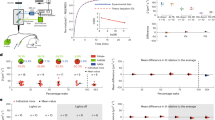Abstract
OBJECTIVES: In studies on substrate utilization, a state of energy balance is often required. Energy requirements are based on measured or calculated sleeping metabolic rate (SMR) or basal metabolic rate (BMR). A study was performed to compare this protocol with adjustment of energy intake (EI) to 24 h energy expenditure (24 h EE). DESIGN: In part one, eight subjects spent one night and the subsequent three days in a respiration chamber. On day 1 EI was set at 1.5*SMR. On day 2 and 3 EI was set at 24 h EE of day 1. In part two of the study, an activity protocol was provided while staying in the chamber. 12 subjects spent one night and the subsequent two days in the respiration chamber. On day 1 EI was set at 1.55*SMR and on day 2 EI was set at 24 h EE of day 1. MEASUREMENTS: Sleeping metabolic rate, diet induced thermogenesis, physical activity index and 24 h expenditure were measured using a respiration chamber. SUBJECTS: Eight healthy normal-weight females (age: 22±3, BMI: 20.9±1.8) in part one and twelve healthy normal-weight males and females (age: 26±2, BMI: 21.4±0.5) in part two of the study. RESULTS: Physical activity index (PAI=24 h EE/SMR) on day 1 (part 1) was 1.55±0.04, close to the predicted value of 1.5, but between-subject variation was large (range: 1.39–1.68). Absolute deviation from energy balance reduced significantly from 1.35±0.30 MJ/d on day 1 to 0.51±0.21 and 0.31±0.10 MJ/d on day 2 and 3 respectively (P<0.05). The latter can be considered as near to energy balance. With the activity protocol (part 2) absolute deviation from energy balance reduced significantly from 0.93±0.20 MJ/d on day 1 to 0.27±0.11 MJ/d on day 2 (P<0.05). CONCLUSION: A three day stay in the chamber allows adjustment of energy intake to energy expenditure, in this way achieving a state close to energy balance. When prescribing an activity protocol the same results can be obtained within two days.
This is a preview of subscription content, access via your institution
Access options
Subscribe to this journal
Receive 12 print issues and online access
$259.00 per year
only $21.58 per issue
Buy this article
- Purchase on Springer Link
- Instant access to full article PDF
Prices may be subject to local taxes which are calculated during checkout
Similar content being viewed by others
Author information
Authors and Affiliations
Rights and permissions
About this article
Cite this article
Schrauwen, P., van Marken Lichtenbelt, W. & Westerterp, K. Energy balance in a respiration chamber: individual adjustment of energy intake to energy expenditure. Int J Obes 21, 769–774 (1997). https://doi.org/10.1038/sj.ijo.0800471
Received:
Revised:
Accepted:
Issue Date:
DOI: https://doi.org/10.1038/sj.ijo.0800471
Keywords
This article is cited by
-
Effects of the once-daily GLP-1 analog liraglutide on gastric emptying, glycemic parameters, appetite and energy metabolism in obese, non-diabetic adults
International Journal of Obesity (2014)
-
Cold‐Induced Adaptive Thermogenesis in Lean and Obese
Obesity (2010)
-
Greater fat oxidation with diacylglycerol oil consumption for 14 days compared with triacylglycerol oil consumption in overweight men and women
International Journal of Obesity (2008)
-
Fat Utilization in Healthy Subjects Consuming Diacylglycerol Oil Diet: Dietary and Whole Body Fat Oxidation
Lipids (2008)
-
Interindividual variability in sleeping metabolic rate in Japanese subjects
European Journal of Clinical Nutrition (2007)



